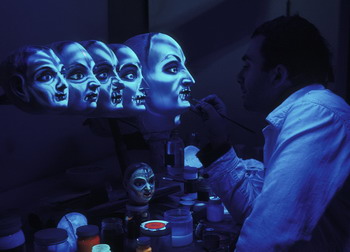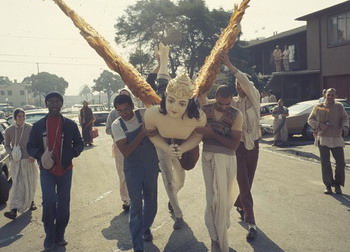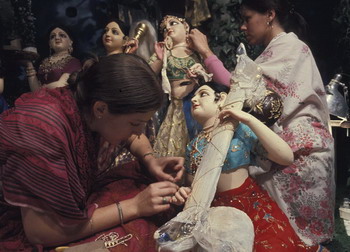The History of the Bhagavad-gita Museum

When His Divine Grace A. C. Bhaktivedanta Swami Prabhupada, Founder Acarya of ISKCON, The International Society for Krishna Consciousness, came to America in 1965, he brought with him his spiritual master, Srila Bhaktisiddhanta Sarasvati Thakura’s, dream of an American theistic exhibition. He had planted the inspirational seed for the Bhagavad-gita Museum in India in the mid- Nineteen Thirties. It was then that he developed an impressive diorama exhibit to present the philosophy of Krishna consciousness clearly and convincingly. That original theistic exhibition, consisting of dozens of dioramas, still draws hundreds of thousands of viewers on its annual to India. To fulfill his own dream, Srila Prabhupada asked some of his own disciples to go to India and learn the art of making “dolls”, the figures displayed in a diorama.

In March of 1973, Srila Prabhupada visited with disciples working at the New York temple. Baradraja dasa, then future Museum designer and director, relates that, “One day all the artists were talking with Srila Prabhupada in his room. He was asking about the various paintings we were working on [for his books], and there was a lot of discussion. Then suddenly he said something that surprised everyone; no one knew what to say. ‘I want someone to learn how to make dolls,’ he said. What did he mean? Of course, none of us actually knew what he was talking about. He just kept speaking of ‘dolls.’ He told us that these dolls were made in India. ‘These doll makers are very expert. I want one of you to learn from them.’ It was a complete mystery. What were these dolls? Srila Prabhupada looked around the room he looked at all the artists. Then he turned to me and said, ‘Baradraja, you will go.’ ”

By the summer of 1973, the small group of devotees chosen by Srila Prabhupada to pioneer the diorama project had arrived in India. Adi-deva dasa, another original Museum artist, recalls his early experiences in Mayapur, India. “I remember the first thing we made in our class. The teacher had us sit down and make a clay mango. We showed it to him, and he rejected it and had us make another one, and another, and another. I must have made a dozen mangos, but he wanted us to make it exactly like the one he made.
“Once we got over the mango, he had us make a banana, then an eggplant, then a squash, and so on. Finally we graduated to making animals. We made monkeys and peacocks- all quite small. It was really tedious, and we sometimes felt like quitting. But the thing that kept us all going was that we knew that one-day this work would give pleasure to Srila Prabhupada, our spiritual master. Of course, at this time none of us could begin to understand the scope of this project, the vision of our spiritual master.”

After fifteen months of painstaking training in India, the small troupe of artists returned to ISKCON’s Western World Headquarters in Los Angeles to take up the next phase of the project. “Before we constructed the present exhibit, Baradraja explains, “We presented the whole idea to Srila Prabhupada, with models of all the dioramas. We marked off a corridor in the exhibit hall and set up models of the proposed dioramas all along the way. Srila Prabhupada toured the whole display and approved all of our proposed exhibits. ‘Very good,’ he said, ‘this is buddhi-yoga; you are utilizing your intelligence to preach Krishna consciousness.’
The artists made the dolls in the Museum, using methods essentially the same as those used for thousands of years in India. The basic materials- bamboo, rice straw, various clays, and rice husk- are the same, as are the processes of finishing, painting, and dressing the dolls. But in addition, taking the best from the West, the original museum electronics engineer, Ameyatma dasa, especially designed a computer that synchronized the entire multimedia exhibition— lighting, sound, slide projectors, and special visual and mechanical effects. At the Museum’s grand opening in 1977 Ameyatma said, “We built our own computer because we just couldn’t find anything on the market that could handle such sophisticated programming.”

Srila Prabhupada once told Baradraja these dioramas are “living books.” Baradraja adds, “People say that pictures are worth a thousand words. Well, we have another saying: ‘A diorama is worth a thousand pictures.’” The Bhaktivedanta Book Trust appreciating this special nature of the Museum in cooperation with Ambarisa dasa funded the original installation. In 1984 Guru-krsna dasa contributed to fund the installation of industrial grade projectors and new lighting effects. By 1995 the Museum, due to the influence of time, had fallen into significant disrepair. A major renovation was undertaken with generous funding from Paul Winchel. Later Baradraja’s son, Gauravani, and another second generation devotee, Shayamakunda spearheaded the repair of the delicate clay dolls and envisioned a completely rebuilt control system to be designed and built by a Hollywood show control company. Late in 1999, inspired by the dedication and hard work of the devotees restoring the Museum, Amala-bhakta dasa agreed to underwrite Media Mation, Inc. to replace the show controls with state of the art, digital, solid-state technology. The Los Angeles Temple Board of Directors contributed ample funds to install the equipment, refurbish the facility and complete portions of the original Museum conception never before realized.
The Bhagavad-gita Museum directors wish to especially thank the following devotees for their dedication, devotion, and hard work that has made it possible to bring this matchless gift to the people in general—
Adi-deva dasa
Akilananda dasa
Amala-bhakta dasa
Ambarisa dasa
Ameyatma dasa
Bada-hari dasa
Baradraja dasa
Bhagavat Akincana dasa
Bhaktisiddhanta dasa
Cakradhara dasa
Charuhasa dasa
Bhakta Charles
Catur-Vyuha dasa
Dan Jamele
Dayala Nitai dasa
Dinanatha dasa
Dharmada devi dasi
Dravina-prada dasa
Gauravani dasa
Govinda dasi
Guru-krsna dasa
Hardajna devi dasi
Bhakta Hector
Jaganmayi devi dasi
Jamadagnya dasa
Bhakta James
Jana-jivana dasa
Jayananda dasa
Kavi dasa
Krsna-kanti dasa
Krsna-vilasini devi dasi
Kumari dasa
Kunteya dasa
Kurmayani devi dasi
Lalita-sundari devi dasi
Locana dasa
Madavi dasi
Madhyama dasi
Mallika devi dasi
Manasa-ganga devi dasi
Bhaktin Maryanne
Bhakta Michael M. Batalon
Mrgaksi devi dasi
Mukunda Goswami
Narendra dasa
Bhakta Neal
Nrsimhananda dasa
Omkara dasi
Padma dasi
Padmahara devi dasi
Palika devi dasi
Pandava dasa
Paul Winchel
Pita dasa
Prabhupada dasa
Purusottama dasa
Radhakrsna dasa
Radhika-sakhi devi dasi
Rama-rajya dasa
Bhakta Ron
Rasanatha dasa
Rathagrahi dasa
Ratnabhusana dasa
Rudra dasi
Rukmini devi dasi
Siladitya devi dasi
Sri-garba dasa
Svavasa dasa
Syamakunda dasa
Tirtharthi dasa
Tomastina
Tulasi-pati dasa
Vamanajana dasa
Vidarbha-kanya devi dasi
Vidagdha dasa
Vilasa-vigraha dasa
Visoka dasa
Vrnda-devi dasi
Vrndavana-candra dasa
Yadavacarya dasa
Yadunandana-pada das
